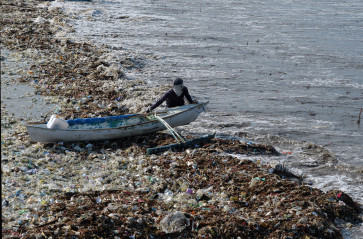Popular Reads
Top Results
Can't find what you're looking for?
View all search resultsPopular Reads
Top Results
Can't find what you're looking for?
View all search resultsPreserving brass handicrafts in Majapahit village
Frozen in time: The front yard of the house of brass craftsman Suyanto âKosemâ features by a building in the Majapahit-era architectural style, in Bejijong village, Trowulan district, Mojokerto regency, East Java
Change text size
Gift Premium Articles
to Anyone
F
span class="caption">Frozen in time: The front yard of the house of brass craftsman Suyanto 'Kosem' features by a building in the Majapahit-era architectural style, in Bejijong village, Trowulan district, Mojokerto regency, East Java.
After working since 1993 with a brass craftsman in Bejijong village, Trowulan district, Mojokerto regency, East Java, which is famous as a brass center, Suyanto decided in 2000 to start his own handicrafy business in the same village.
With his brass casting skills and some capital borrowed from friends, Suyanto, better known as Kosem, opened his own brass handicraft business with the help of his wife Yanti and other relatives.
Various motifs and types of brass products are now on offer to suit different customers' tastes.
In the beginning, he produced statuettes of the Buddha and other gods that were sold through fellow craftsmen, rather than directly to domestic and foreign tourists visiting the archeological site of Trowulan.
The father-of-three later kept striving for increased sales of his handicrafts by seeking customers from different circles, individual consumers buying home decorations as well as art shop owners in Surabaya and Bali.
Today his gallery, named Kosem Art, has five workers to meet growing demands, especially for large quantities of Trowulan brass creations ordered by buyers from Bali. Yanti continues to assist him in the production process as she did at the outset of their business.
Kosem uses wax as a medium and transfers it into molds for casting brass. 'Brass handicraft making has dry and wet casting techniques. I choose the dry method,' said Kosem.
'Dry casting applies wax as a molding means. A model made of wax is wrapped in clay. To make the wax inside melt, the clay is fired at a temperature of over 100 degrees Celsius. The hollow left by the wax is the mold where brass is cast,' the 40-year-old said.
Pouring in: Kosem the brass craftsman pours molten brass into clay molds ready to be dried under the sun.
According to the junior high school graduate, the various sizes of wax models covered in clay are first dried in the sun. 'In the dry season they're dried from morning until afternoon before firing with firewood the next day. In the wet season it takes days for them to dry,' he added.
After being molded, sculptural brass casts of diverse sizes are produced. Cleaning and finishing by filing and cutting off unwanted parts determine the final shapes of statuettes. Coatings are applied if certain colors are needed.
Accurate workmanship is required as the handicrafts created through generations are inseparable from the heritage site of Trowulan, which is strongly believed to have been the hub of Indonesia's largest maritime kingdom, Majapahit, during its heyday.
In meeting market demand, Kosem said there should be a broader variety of creations to prevent keep consumers interested. 'Sometimes they come with their own designs. It's not hard to fulfill as long as they agree with our prices.'
Kosem's Hindu-Buddhist handicrafts, occasionally having some semblance of contemporary art, attract visitors to Trowulan under cultural tourism programs as they wish to get a better idea of the Majapahit kingdom. He also invites guests to his gallery and workshop to learn the entire process of brass casting.
The results: Two female relatives of Kosem break the clay molds and recover the brass sculptures.
Kosem hopes that local and foreign tourists will get to know the brass handicraft industry in Bejijong even more closely, so that the village can eventually grow into a famous Majapahit-style location producing typical Hindu-Buddhist figures and other brass sculptures.
Bejijong is easy to find because dozens of houses belonging to craftsmen and ordinary residents along the village's main road have been renovated by the Mojokerto Tourism Office with front-yard structures in the style of Majapahit architecture.
'My house is among those with a Majapahit styled structure measuring 3 meters by 5 meters, and 4 meters high, which I've turned into the gallery. Some non-craftsmen with the same buildings use them as sitting rooms,' said Kosem.
The village's main road, connecting the Mojokerto Bypass and Brahu Temple, provides access leading to several historical tourist destinations like the Siti Inggil Cemetery, Maha Vihara Majapahit and Gentong Temple.
The Majapahit structures have replaced old terraces so that the local settlement looks like a village from the Majapahit era. Their walls were built from red terracotta bricks to look natural, with foundations almost a meter high, and there are twin doors and two windows on both sides.
The Majapahit village project was undertaken by the East Java provincial and the Mojokerto regency administrations, involving over 100 houses in three villages of the national cultural heritage zone. Besides Bejijong, the other villages are Sentonorejo and Jatipasar.
'We didn't pay for construction workers and renovation materials. Everything was provided by the government. We only prepared tea or coffee for them, as they also got food rations,' concluded Kosem. The project was meant to support the zone's archeological importance as a tourist destination in Bejijong.
Initial step: Kosem's wife, Yanti, covers wax models with clay molds. The clay-covered models are then fired at temperatures of more 100 degrees Celcius to melt the wax.
Finishing touch: Kosem cleans and refines a brass sculpture.
' Photos by JP/P.J. Leo














